Photo/ Takanori Ota
One day in February.
I, Ai Fukuda, a member of the STEEP editorial staff, headed to Nozawa. So far, I have focused on basic skiing, and my ski life has been far from free skiing or backcountry skiing (BC). "I want to ski the vast BC!" How to use avalanche gear? How to paste the sticker? I got information that they are holding a BC course for beginners who will teach you from scratch even if you do not understand at all. COMPASS HOUSE, which has three shops, a cafe, and a rental shop in Nozawa Onsen Village, Nagano Prefecture, offers classes that are easy for beginners.
We are planning a wide variety of tours for various levels during the season, but in order to participate in any tour, it is a prerequisite to take the "Beginner course that makes BC more fun".
The reason for this is to give advice on safety and how to climb so that beginners of BC can get used to the tour smoothly, and to provide a place where they can warm up so that they can participate in the tour with peace of mind and enjoyment.
And it is also to match the level of the tour participants. For example, if a BC beginner participates in a tour for experts, they will not be able to keep up with the skiing and climbing, and other participants will have to wait for the beginner, which is stressful for both of them. It can be said that it is a device to enjoy a precious day spent in BC as much as possible.
In this article, I would like to share with you what I learned from the workshop, and what I felt from my point of view, as a beginner, and what information I should know for skiers and snowboarders who want to try BC.
Exciting start of BC workshop
On the day of the event, we gathered at Nozawa Onsen Ski Resort, "Mt.DOCK" at the foot of the Nagasaka gondola. The participants (subjects) this time were me and Mr. Lars, a shop staff from Australia. Both of them are inexperienced in BC, of course. The instructor for such beginners is Mr. Takaya Kawaguchi TKY.
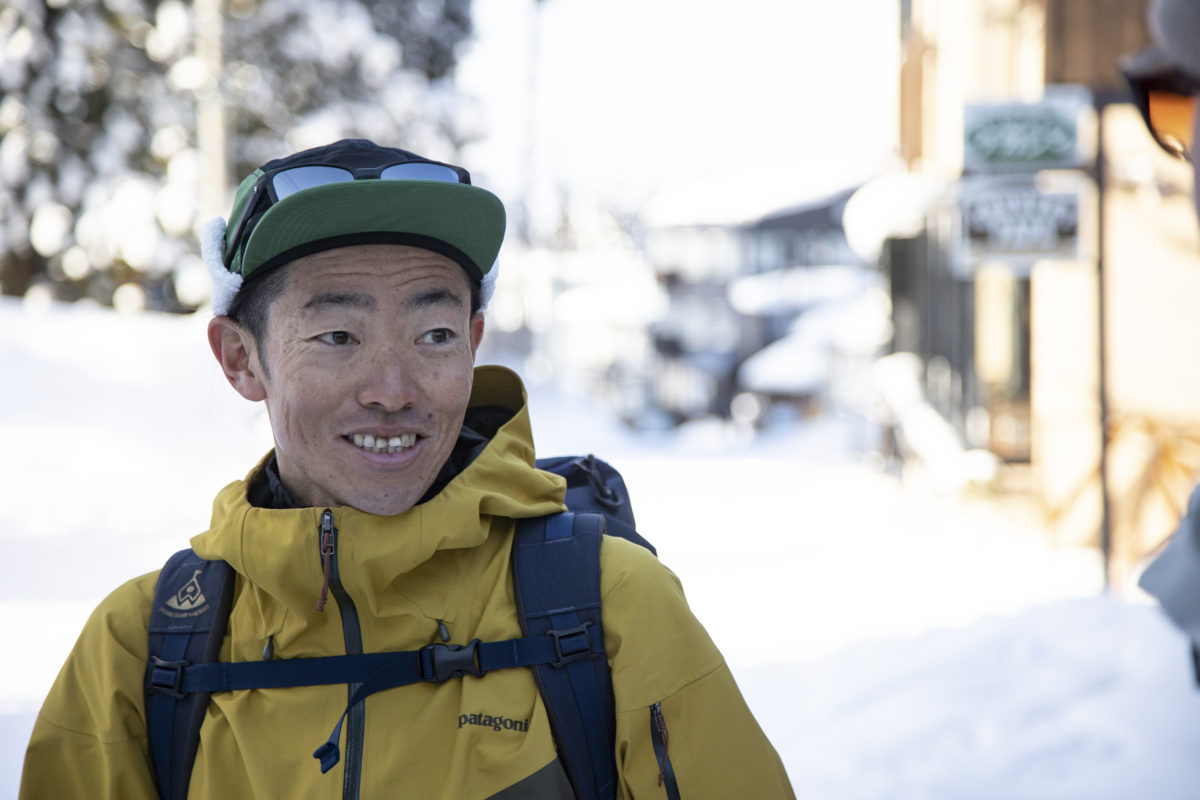
Before leaving, I checked the equipment. Even when I look at the gear I use, I get the impression that it looks like camping gear and that what is this pico pico? You can rent everything here. It's a good idea to rent one and experience it first before buying it without knowing what it is.
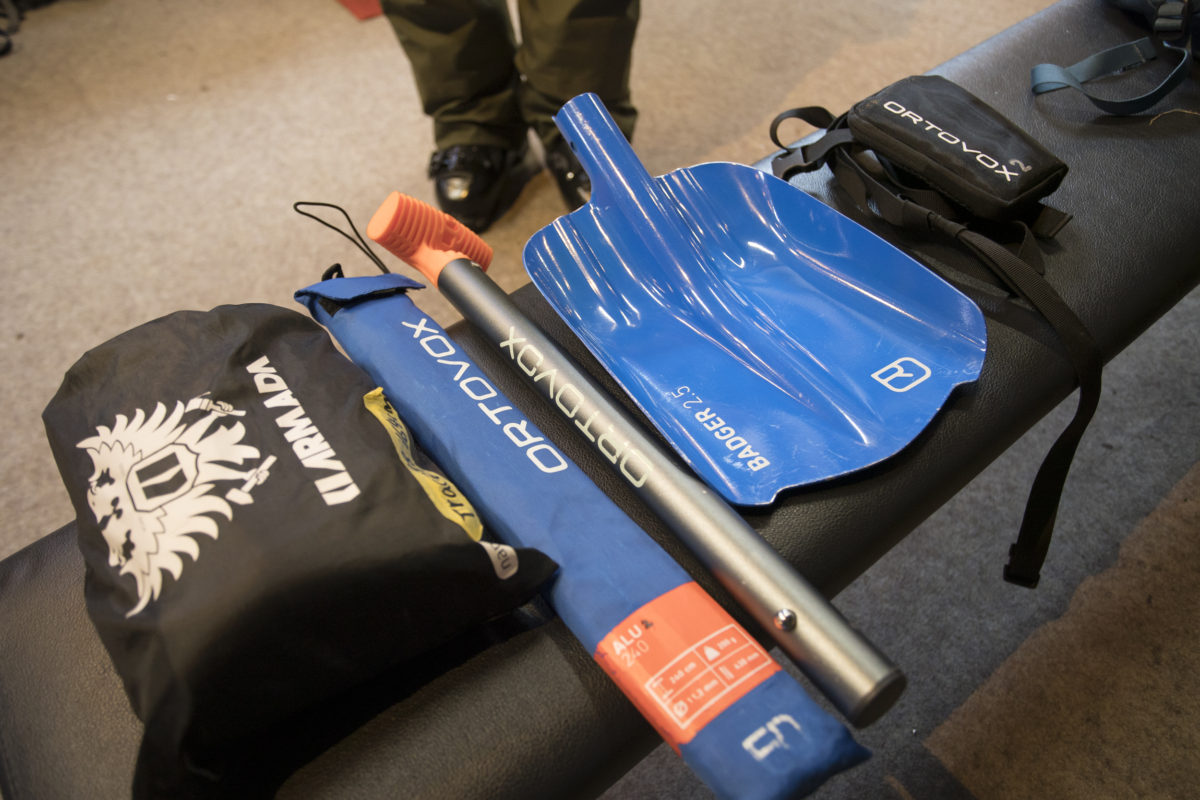
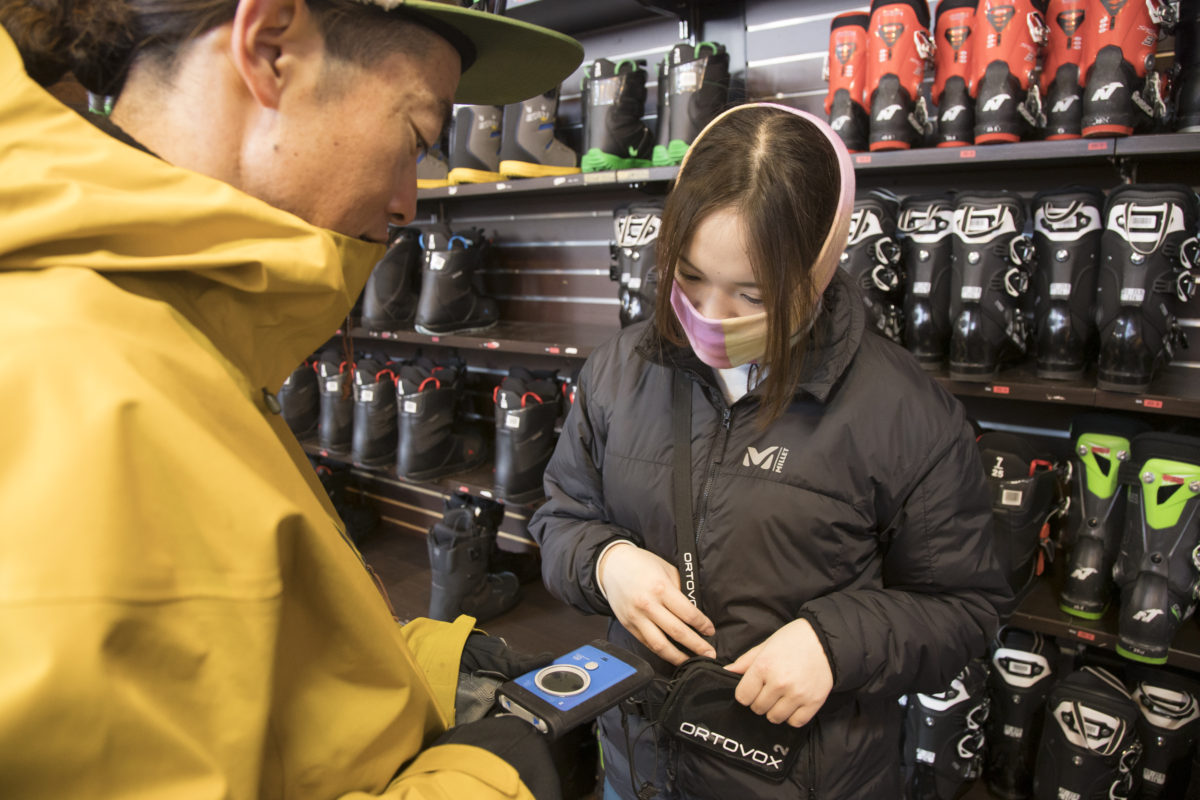
The above items are essential for a beginner's course, but this time it also serves as a mini BC tour, so prepare suitable ski gear. If there are bindings and poles equipped with walk mode, it is ◎. If you don't have one, you can also rent one. I usually use skis with alpine bindings, so I borrowed fat skis with bindings that I can walk on.

And before heading to the mountain, the participants announced their enthusiasm. "I'm going to have fun!" "I'll do my best!"
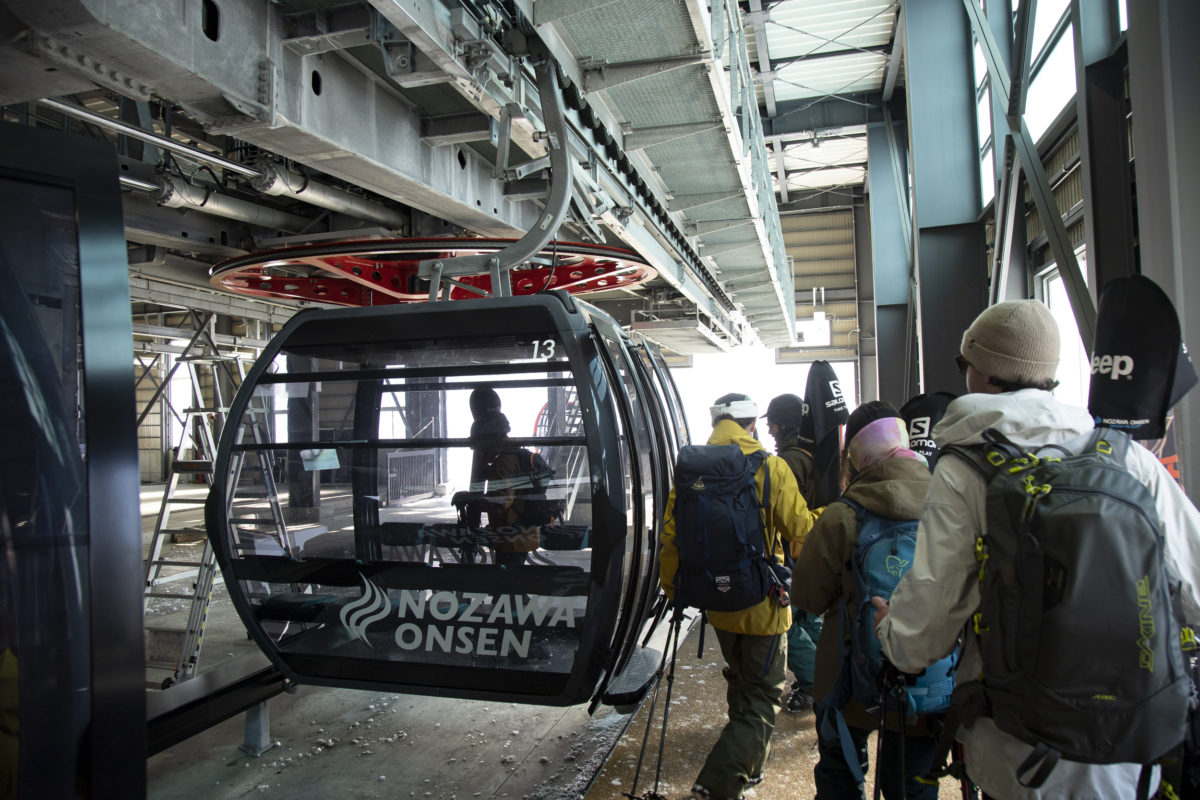
The place we aim for on this day is Mr. Kawaguchi's favorite point.
Go up on the Nagasaka gondola and proceed to the BC area. *Climbing registration is required to enter the BC area. In the tours and seminars hosted by this Compass House, you can rest assured that you will be issued a mountaineering registration for each participant.
get ready to hike
A spacious snowy field is the training field. Here, we will give a lecture on what to do when actually hiking, such as how to attach ski stickers, how to switch bindings to walk mode, etc. Usually, it is done on a sloped and unstable place, so practice on a flat place first so that you can paste it quickly here.
First of all, try sticking a ski sticker. Clean off the snow on the soles of the skis and gradually attach the stickers. If snow gets between the ski and the seal, the seal will come off easily while walking. So I'm going to stick it on carefully. It was windy that day, so the sheet attached to the adhesive surface of the sticker was blown away by the wind.
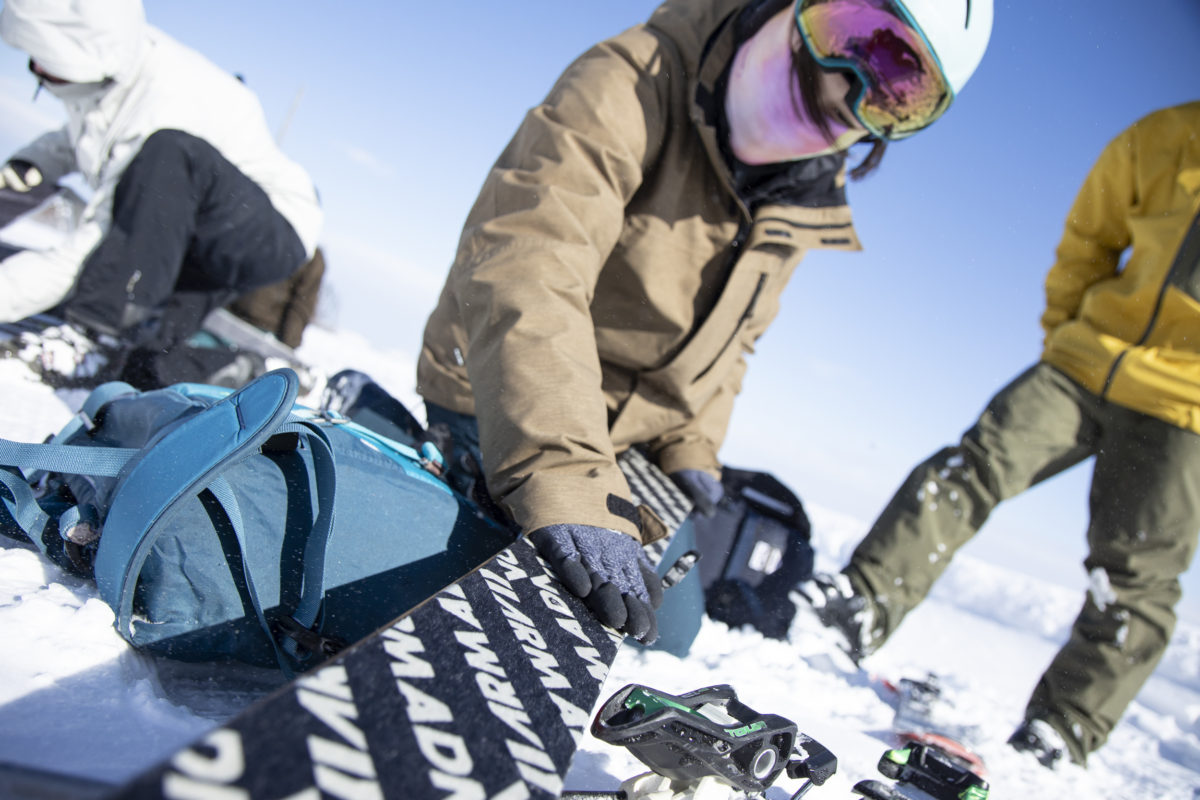
Frame Tour bindings have walking and downhill functions, so you'll learn to switch modes.
Just remove the lever from ski mode to walk mode. Conversely, from walk mode to ski mode, hold down the bindings and slide them on. It was my first time and it was quite difficult.
Switching the lever is stiff and difficult to do. Furthermore, when switching to walk mode, the snow on the rails on which the bindings are attached must be properly removed. It's a difficult task for me, who is lazy, but I thought that if I came off while skating, I practiced carefully and repeatedly.
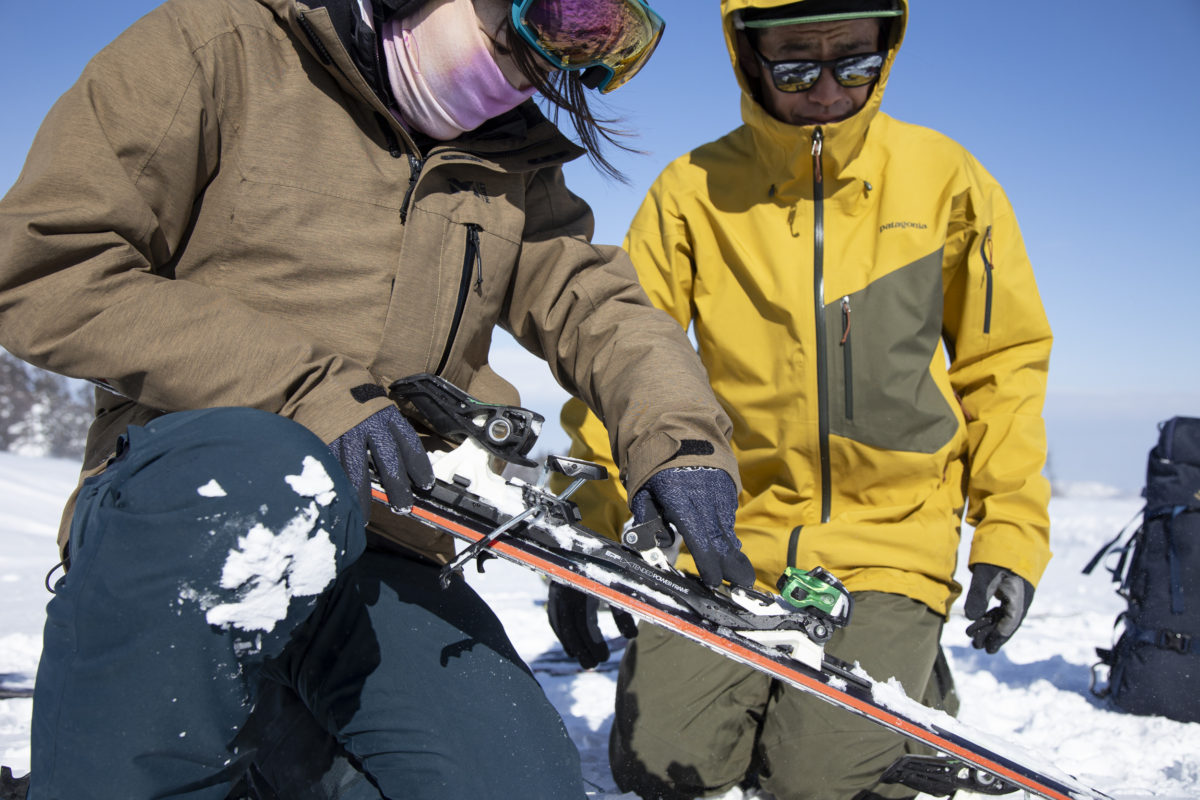
By the way, the boots did not have a walk mode, so when I walked, I opened the 3rd and 4th buckles of the boots and the power belt almost completely. The wider the range of motion in the front and back of the boot, the easier it is to walk and the less fatigue. I was told that the poles when walking should be longer than when skating. Pole with adjustable length is convenient for BC.
So much to do. Although it is the first time to use all the tools, it is okay to be completely ignorant because they will teach you carefully one by one. Let's learn each point by participating in the course.
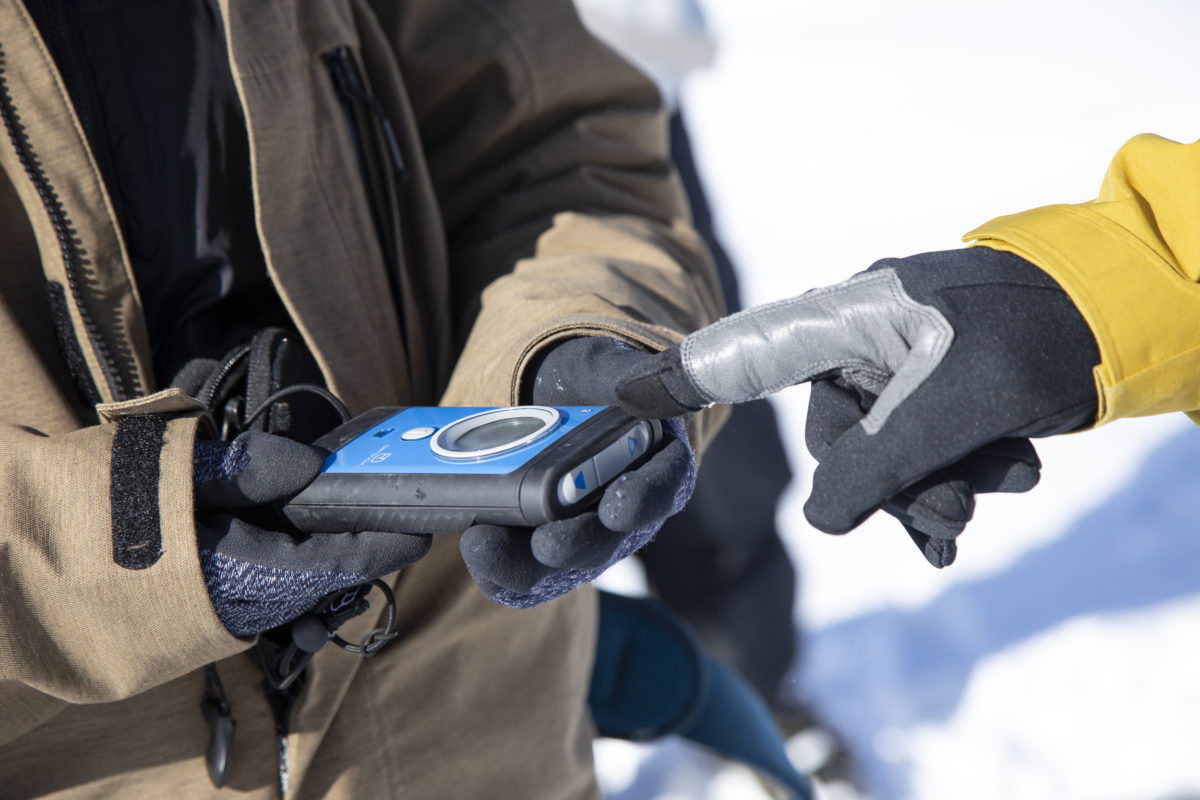
And I actually walked on a wide snowfield.
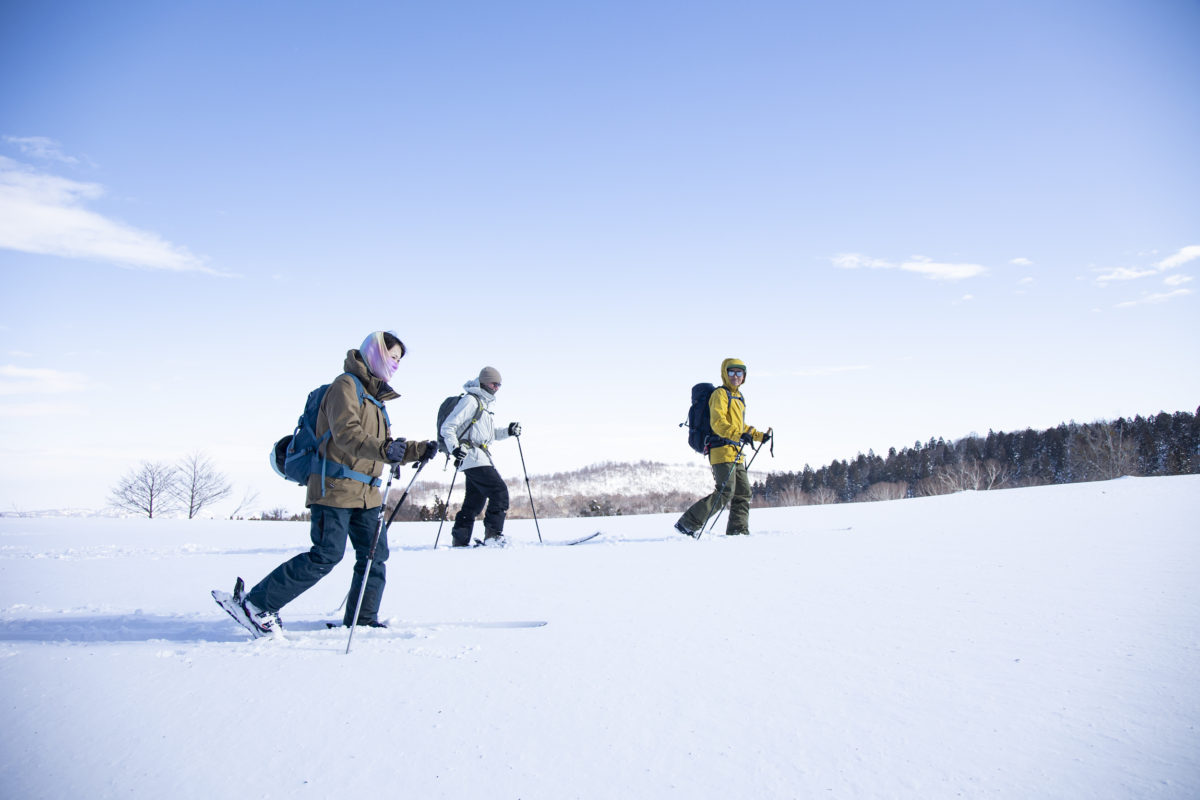
When I first walked with the sticker on, my impression was "somewhat strange". Normally, "slip" skis will bite firmly on the snow surface. Like cross-country skiing, I walk with my heels floating, so my hands and feet come out at the same time.
Learn BC's "Kick Turn"!
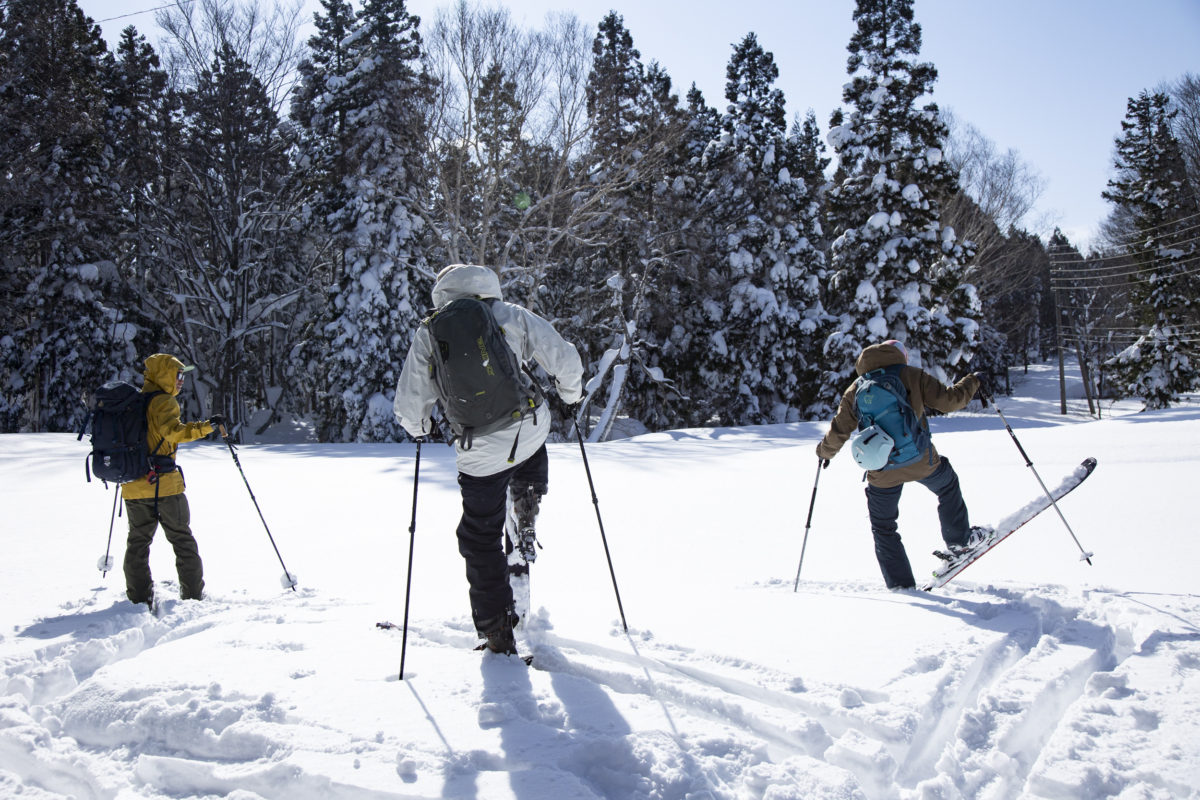
The next thing I practiced was the "kick turn".
It's not what people who have taken lessons at a ski school or avid skiers who peruse a ski course imagine. A kick turn as we know it is a 180-degree change in ski direction while standing still, but a kick turn in BC is something else. When hiking steep slopes, do not climb straight up aiming for the top, but proceed in a zigzag manner. At that time, it is a necessary skill to change direction.
Here is how it looks
I understand that the basic kick-turn method is like this.
Go a little further than where you want to change direction, spread your foot on the mountain side and put it firmly in front.
Fix the position of the leg with the pole out, place your weight on the leg that is firmly in front, and pull up the other leg. Pull your heels back, keep your knees in place, and get into a position where the skis are directly under your body and match your forward legs. Mr. Kawaguchi said two points for beginners.
1. First of all, don't panic
2. When pulling the foot on the valley side, fold the upper body forward
I was taught various things, but the kick turn was more difficult than I imagined. Since the heel comes off, the board cannot be lifted as expected, and the balance is lost unexpectedly. Since I have a feeling that I'm not good at it, "I want to walk as straight as possible. I don't want you to turn around" crossed my mind.
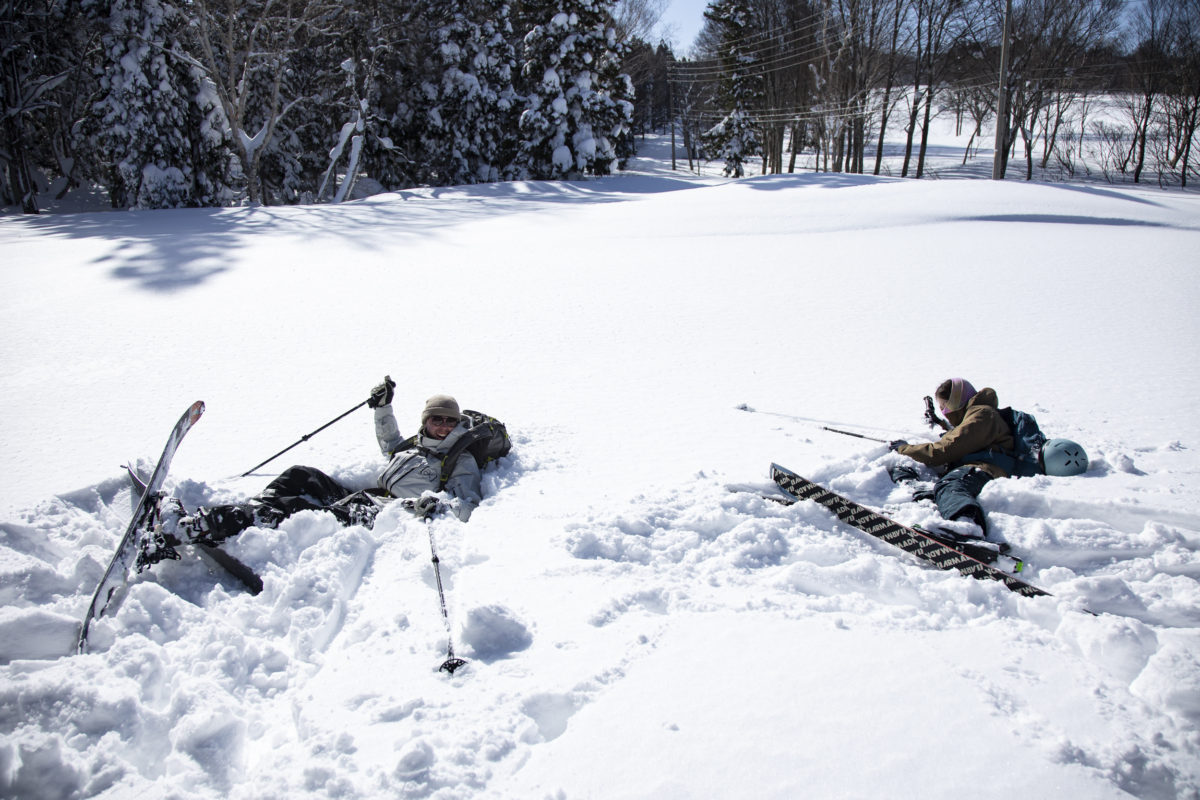
And when you fall, you can't get up. Even if I fell while skating, I was able to recover quickly, but the opponent was soft and fluffy powder. It's hard to know how to apply force, and even if you try to use the snow for support, you'll be pulled into the depths. It was embarrassing for a grown-up to ask a guide to provoke him...
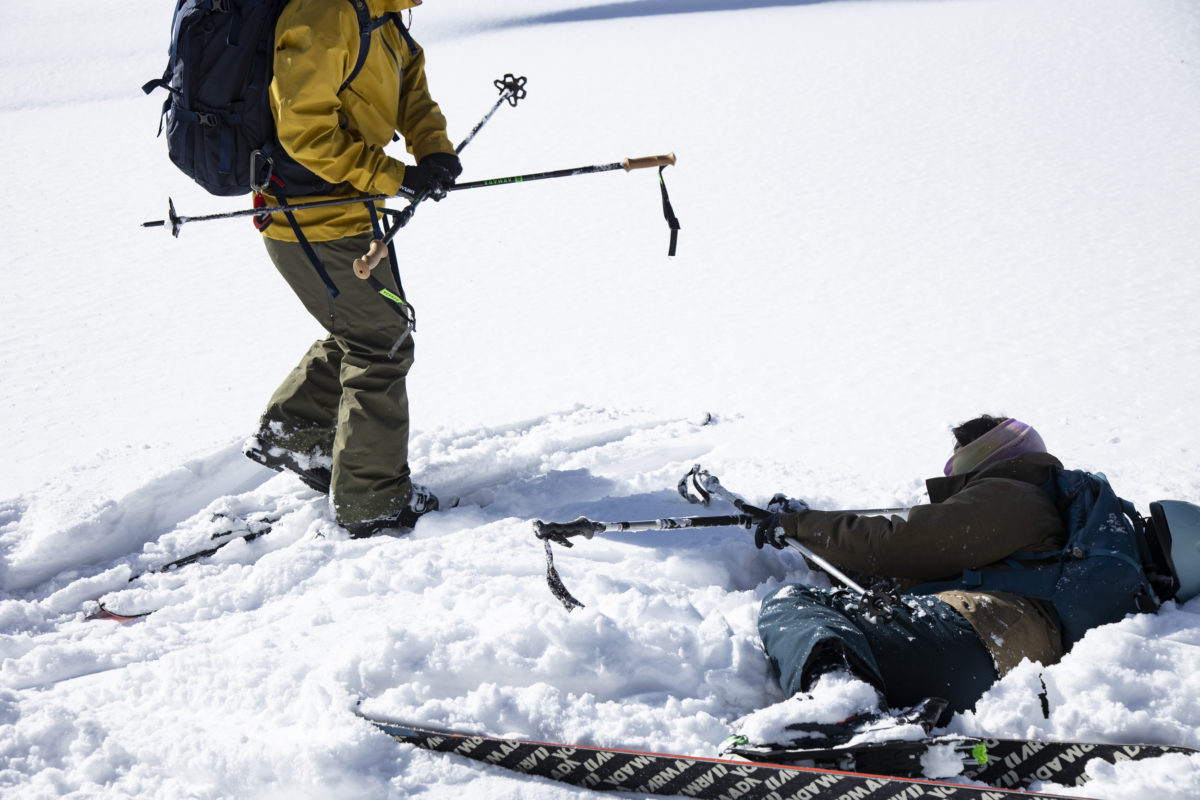
On the day of our visit, the weather was fine and we could see the scenery in the distance. Of course, the snow is not compacted, so if you walk in boots, you will get stuck. Only in BC can you enjoy the indescribable comfort and mysterious scenery as you walk through the forest where there are only animal tracks.
Avalanche gear training is also in actual combat format
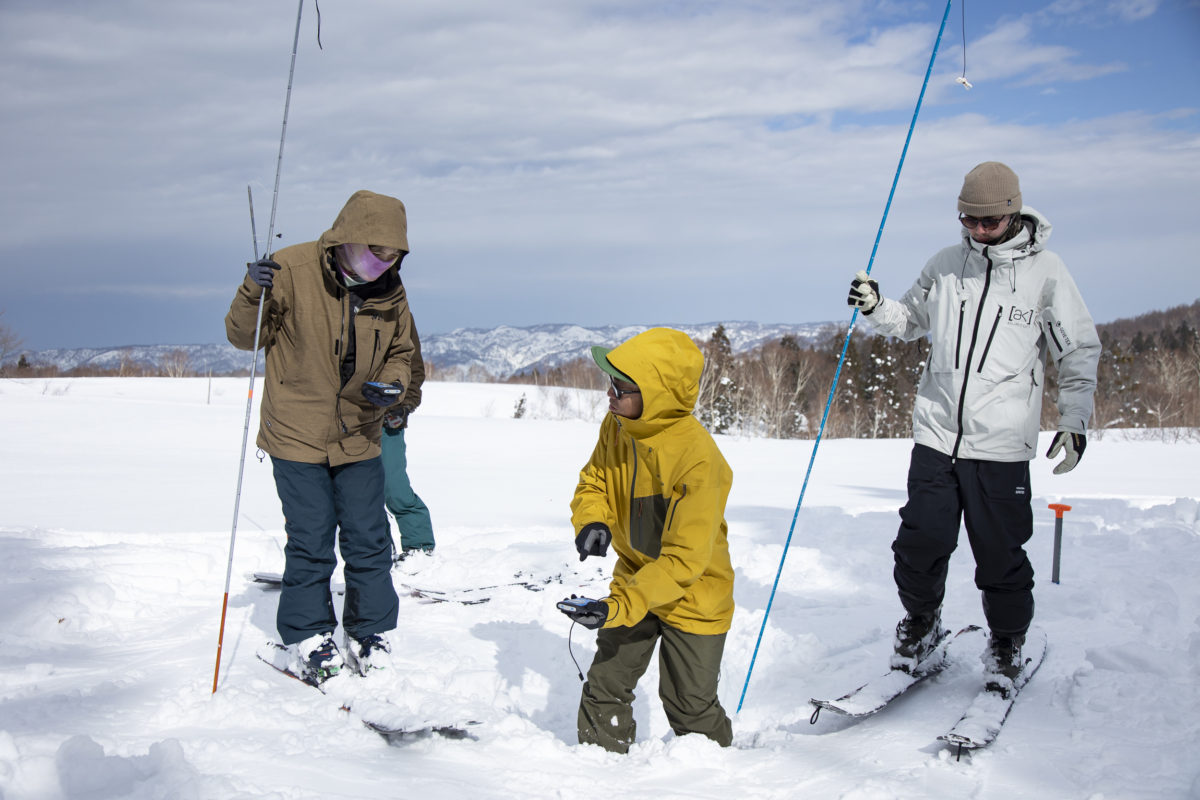
Next, a practical workshop on avalanche gear, which is said to be BC's "Three Sacred Treasures," began. Based on the beacons you learned how to use at the beginning, it is a lesson to find and dig up buried beacons assuming an actual avalanche accident.
"An avalanche has occurred and my friends are buried! Please find it quickly!"
With Mr. Kawaguchi's voice as a signal, I switched my beacon to search mode.
The beacon displays the location (distance and direction) of the caller, so you can look for it, but... In fact, at this time, Mr. Kawaguchi was doing "tricks" for the leading members other than us students.
It took me a while to find the location of the caller, and I wandered around the place, changing the display from the front to the back. Originally, when switching to search mode, all members on the spot must switch to "search mode".
However, one of the leading members did not switch, so the search point was never fixed. You can also learn about such cases that can actually occur at the workshop.
I didn't know that probes that I touched for the first time could be assembled in one shot. If it's a real emergency, you can't just say "I don't know". I keenly felt that these seminars would be very useful.
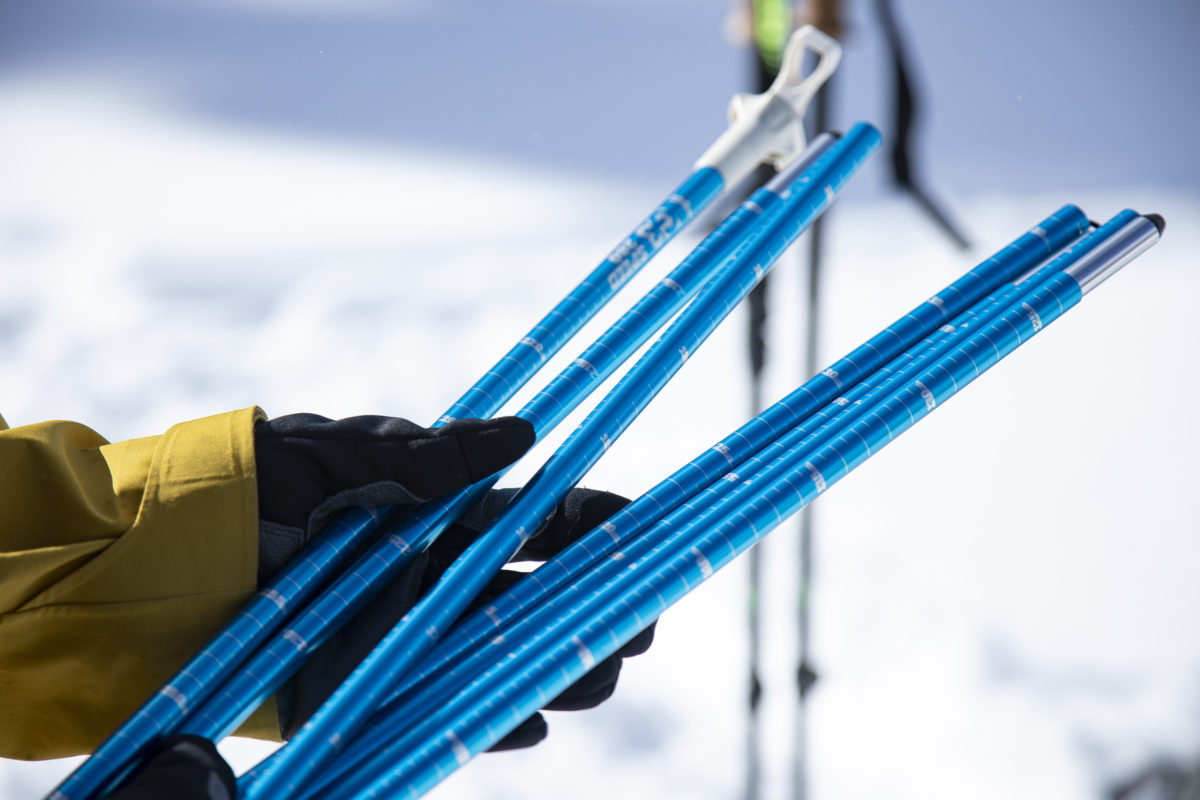
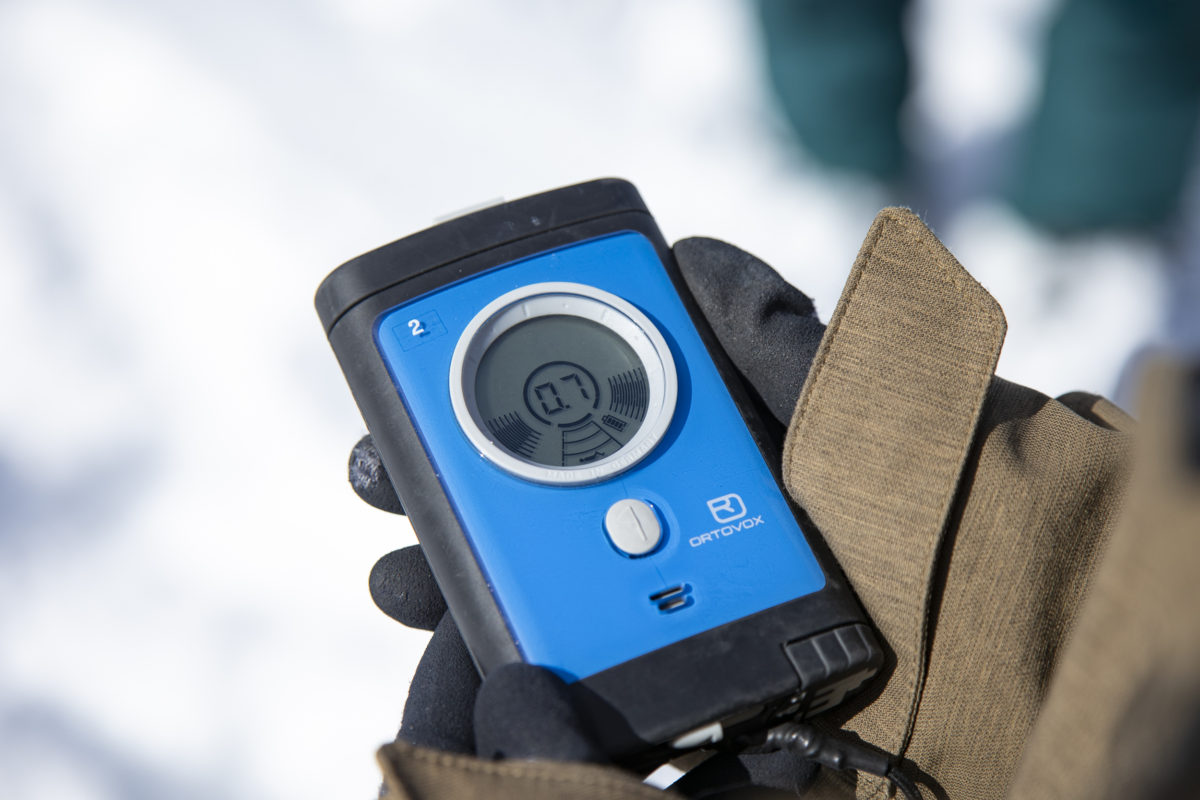
Learn how to use each gear and master it. These are the only things you don't know until you actually get your hands on them. It's kind from the beginning, even for completely ignorant beginners, and it teaches in a fun way with examples, so I would definitely recommend it to those who want to challenge BC from now on.
Beginner mini BC tour
Normally, the beginner's course ends here, but this time we decided to try a few runs, so we started a special tour. Move to where Mr. Kawaguchi is aiming and say, "Let's try skating!"
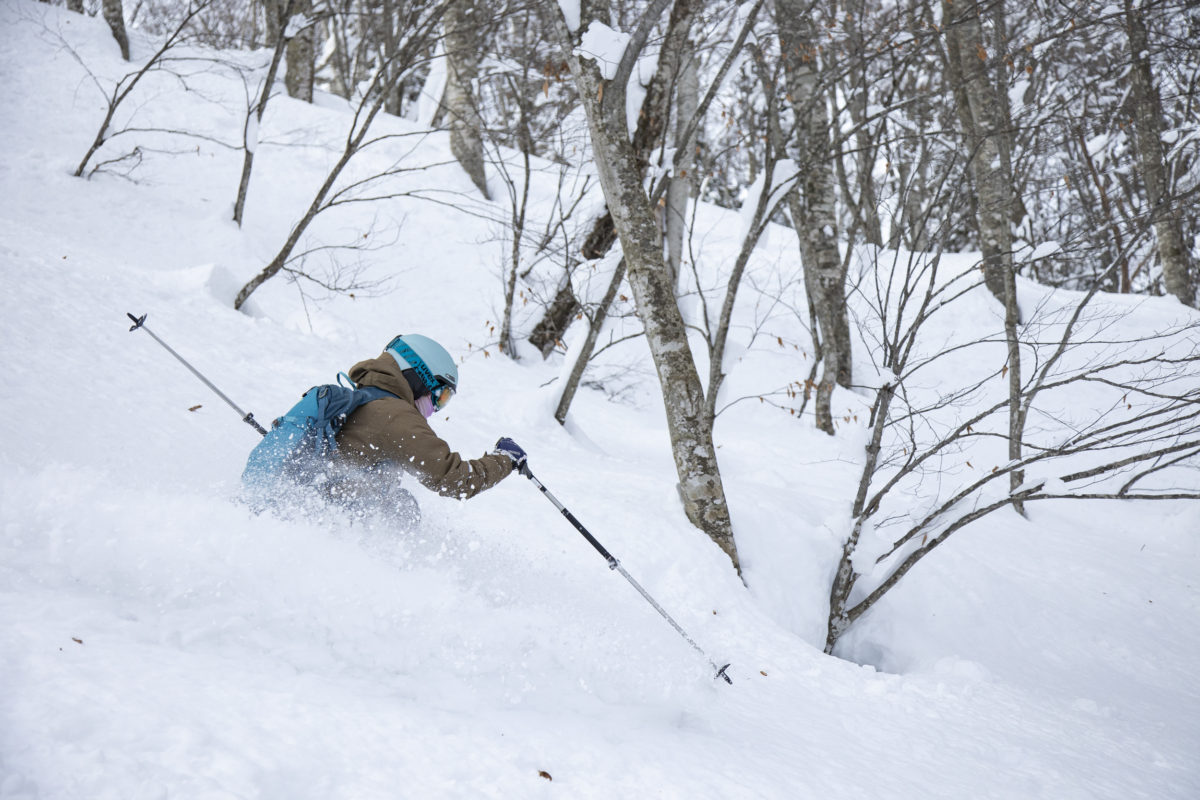
Almost my first BC runway.
I slipped one of the tension. Honestly, it's the same as roller coaster horror. The roller coaster that I felt scared when I was young is now addicted to the thrill, and the first one is nothing but fear, as if I went back to my childhood. Since it had snowed until noon the previous day, powder remained on the north slope. Of course, it's BC, so it's a no-track slope where no one is skiing. As soon as I started to slide, I thought, "Oh, maybe it's fun?"
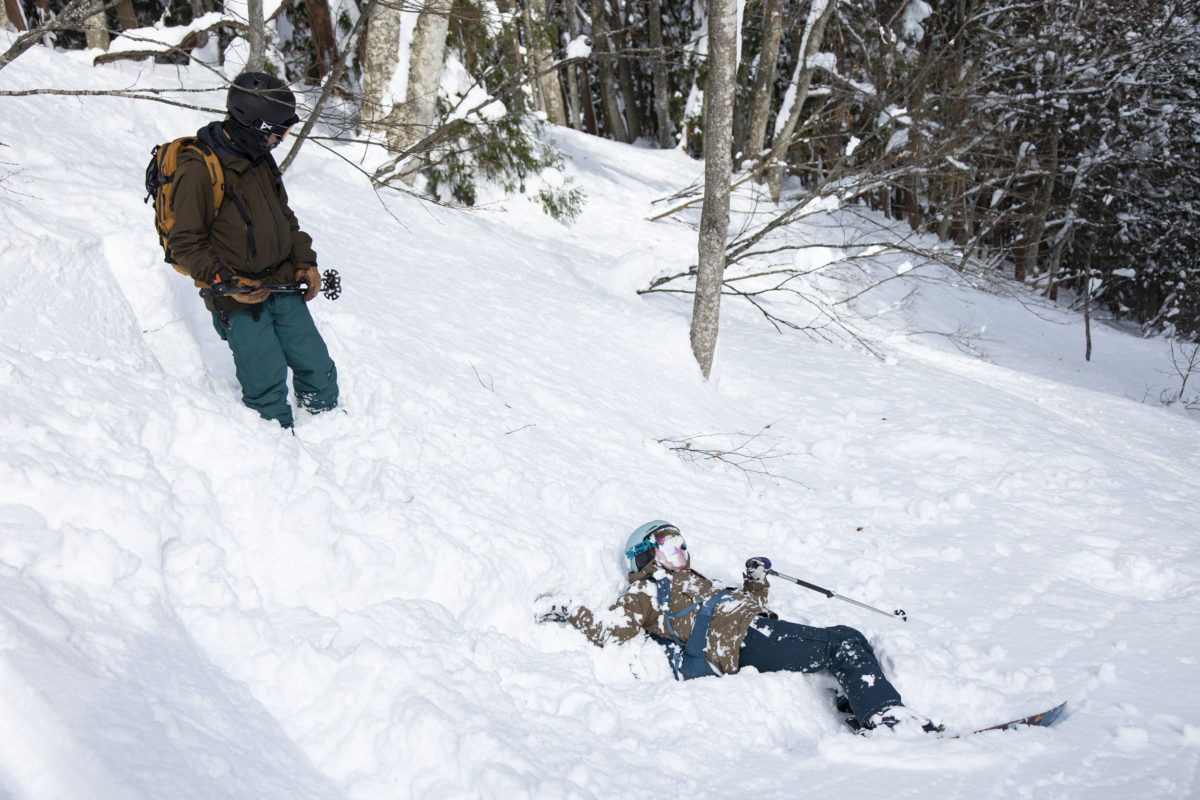
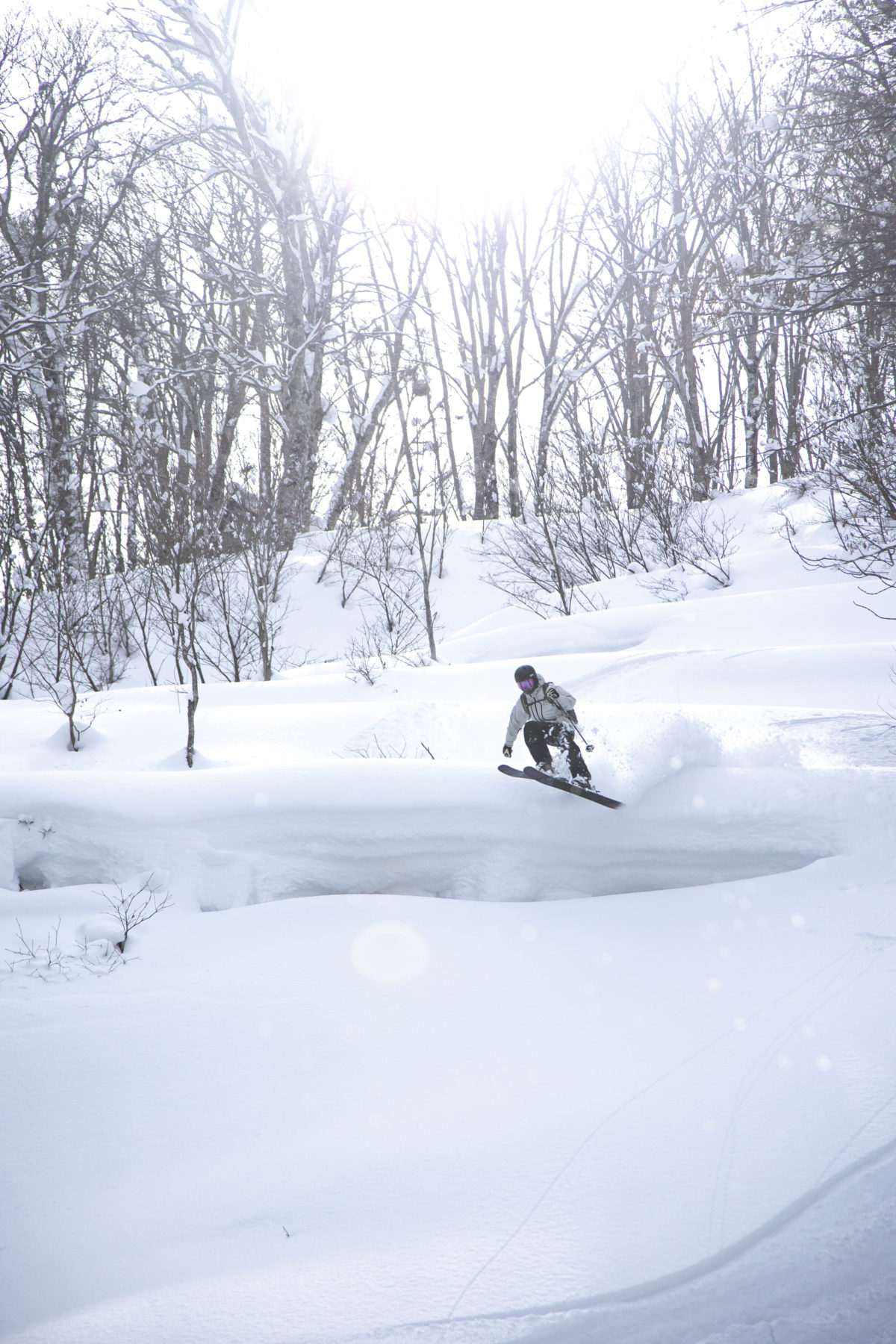

I was overwhelmed by everyone's skiing. I don't want to fall and be buried in the snow, but I want to skate cool... let's practice properly from now on. With that thought in mind, the fun but slightly difficult tour continued for a while longer.
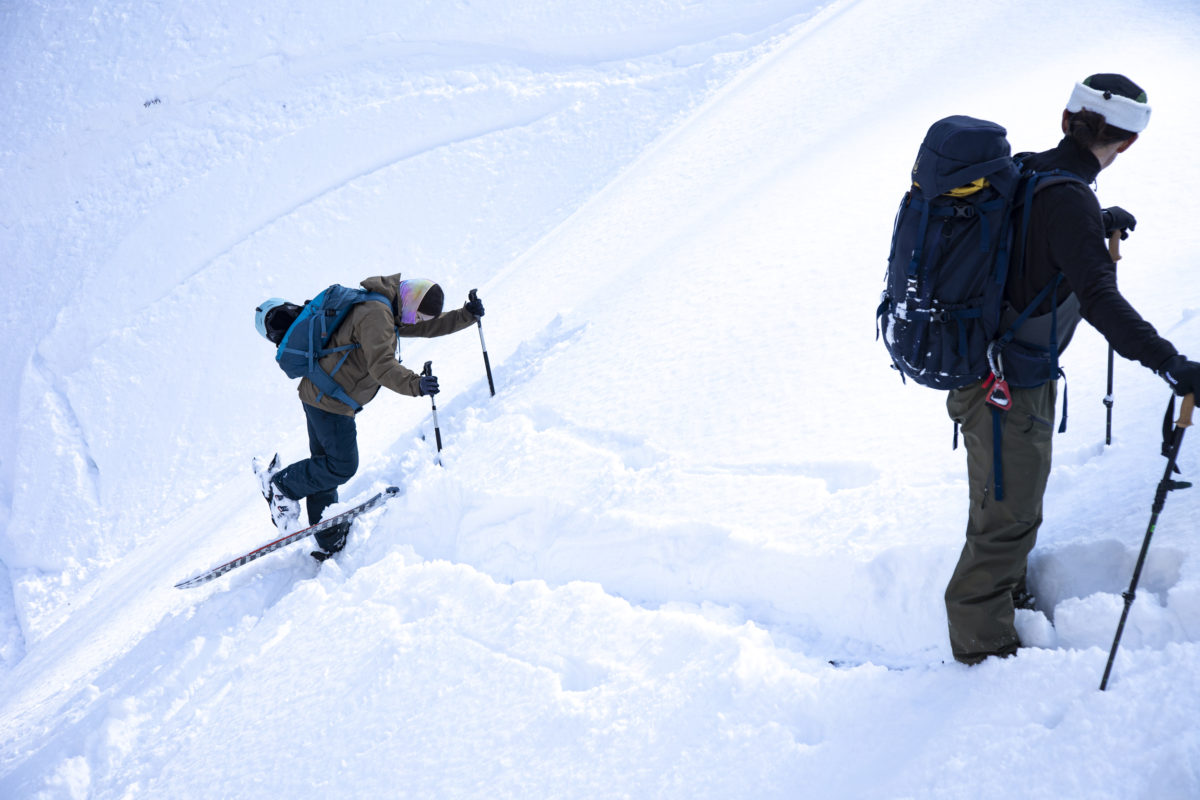
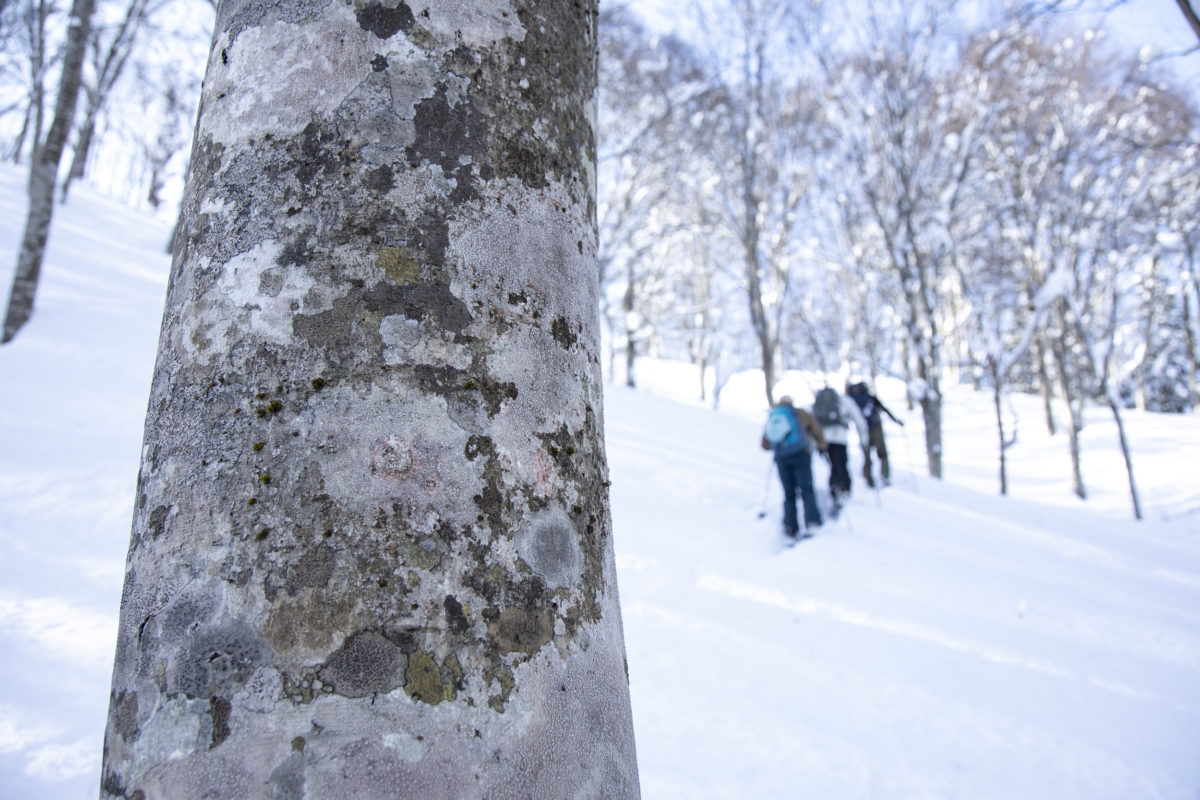
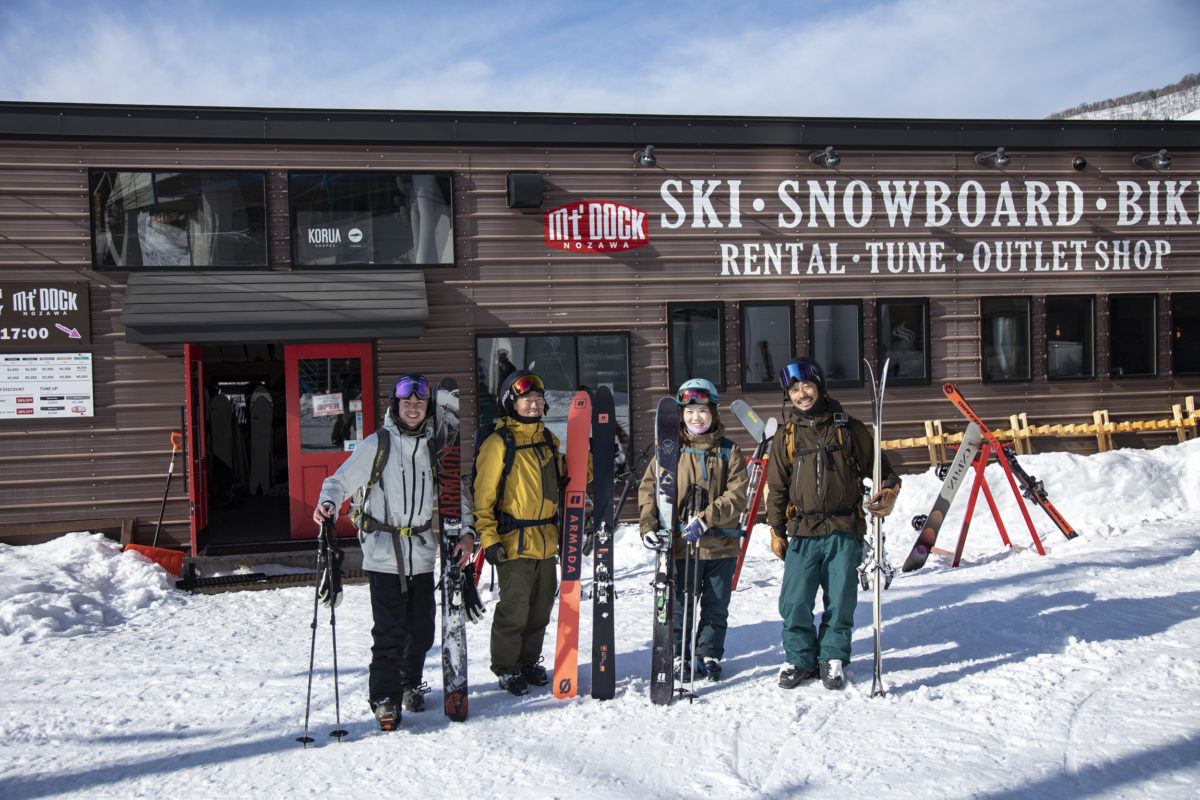
I was tired because of the unfamiliar movement, but I felt a pleasant feeling of fatigue, like after a good workout. The weather was good, so the tour was even more fun. This makes me want to participate in the next step. It was the first BC tour that made me feel like I want to continue.
I wish I had this! Things to prepare even for beginners
This is the first time I've participated in a tour, and I'll list the things I thought, "I wish I had brought that!", "I want this...". There are many things that I personally thought were necessary, but I would be happy if those who start BC in the future can refer to them.
sunglasses
I was thinking only about "slipping", so I had forgotten. Normally, I would ski by turning the lift, so the goggles were enough, but it only takes a few minutes. Preparing to climb and climbing time is overwhelmingly longer. And it was sunny on the day of the interview. In addition to the direct sunlight, the glare from the snow hurts my eyes. The following are must-have items.
beanie or cap
I was only thinking about sliding, so I forgot. It is important to carry as little luggage as possible, but it is something you want to bring without forgetting. There was nothing to block the wind at the place where I took the avalanche gear training, so I felt the cold being blown directly by the wind. Add this to your list of items to bring.
layering
“Layering” is an essential item that should be considered more than what should be aligned. I've always been a "layering? Anything is fine as long as it's not cold" kind of thing, so I've been wearing HEATTECH and a hoodie, something that's closer to everyday wear, but this tour really made me realize it. What I felt more than cold was "hot!". I was sweating a lot and not being able to put on and take off was very stressful. The scary thing after sweating is getting cold. The heat and cold put a strain on the body and ruin the whole day. I learned why I need a highly functional innerwear.
According to our guide, Mr. Kawaguchi, layering is the most important thing to have. You should wear good layering instead of buying cheap ones.
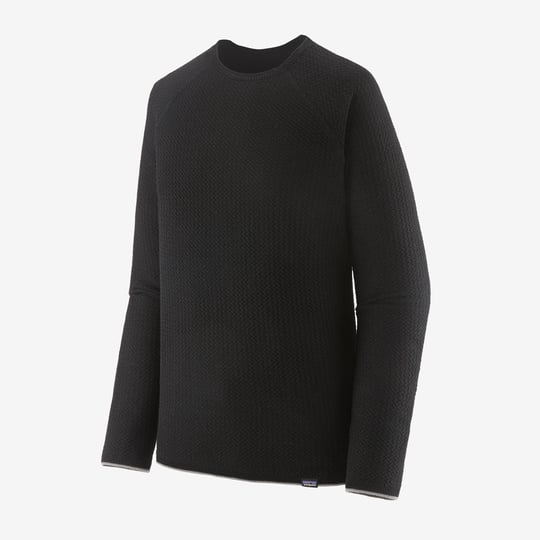
By the way, what do you recommend for Mr. Kawaguchi? When I asked, it was Patagonia's base layer "Capilene Air". Made from a blend of 51% merino wool and 49% recycled polyester, it is a highly breathable material that wicks away moisture, dries quickly, and is also odor resistant, making it a perfect item for BC.
Product introduction on Patagonia official website: https://www.patagonia.jp/shop/mens-capilene-air-baselayers
Backpack
What I felt during this tour was that there were more things in and out than I had imagined. There are many bulky items such as helmets, outerwear, and avalanche gear. I felt that I would like to get a backpack that is easy to put in and take out and has a high storage capacity. I especially want something that can hold a helmet or attach to a backpack. The reason I keep my helmet hanging from the straps of my backpack is because it feels very intrusive when I walk.
boots
This time, I rented the skis, bindings, and poles, but the boots were my own. After walking and climbing all day, there was actually a lot of bite in the boots. Originally, it was a tight fit for use in exams and competitions, so my legs were numb when I went down the mountain. Alpine boots can be used as is, but it is also necessary to change to boots with a little more room.
These are the things I want to have. Other hardware items feel that rental is enough for beginners. I think that as I gradually get to know the deep world of BC, I will find something that suits me. I would like to know what the guides and experienced people use and recommend, and gradually prepare my own gear in the future.
Nozawa Onsen Ski Resort attracts overwhelming support from domestic and foreign skiers of all genres. At "COMPASS HOUSE", which has a shop at the foot of it, there are many tours by level as well as beginners' courses. Click here for details
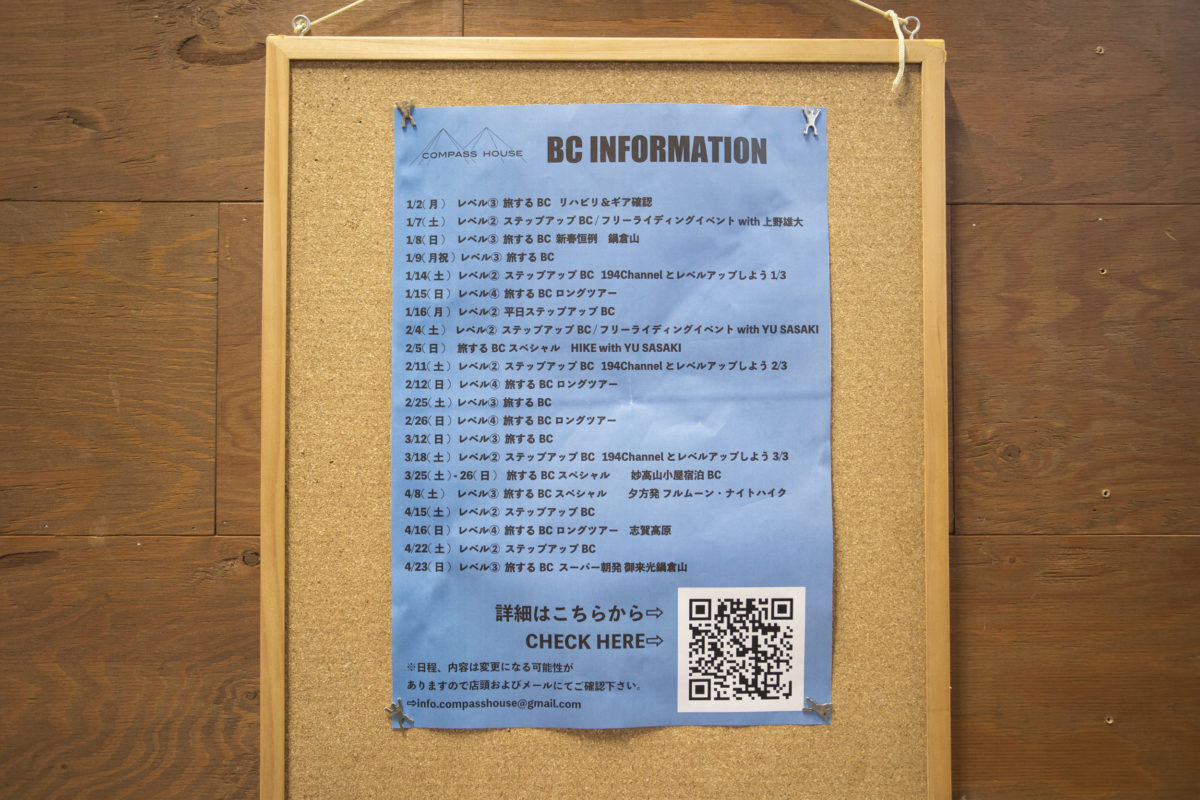
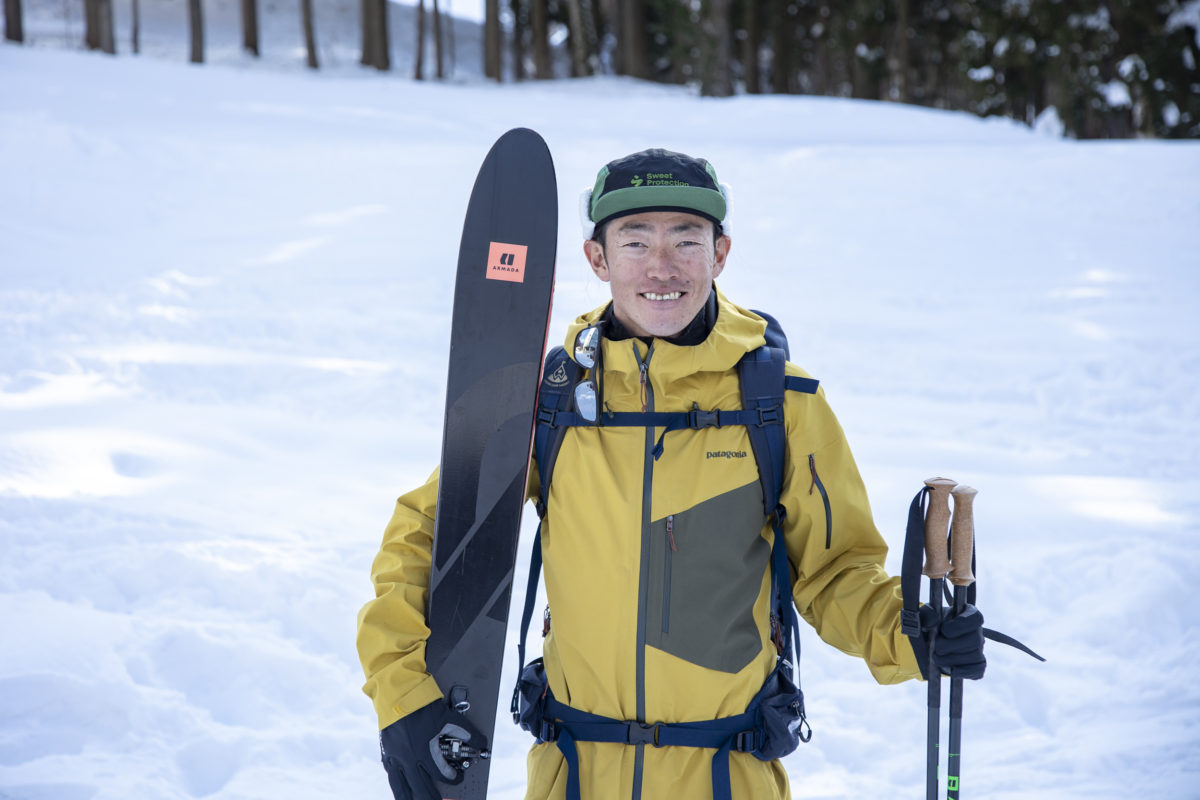
<Person who taught me this time>
Kawaguchi TKY Takaya
He took a leave of absence from university to practice freestyle skiing, and experienced the world's level after living in Bum in Whistler and Banff, Canada.
After a solo ski trip to Yukon Alaska that spring, his sense of values changed, and he began to focus on ski trips rather than park riding. He has traveled to over 50 countries on skis and surfboards so far, including a round-the-world road trip. His curiosity leads him to travel to remote areas and meet ethnic minorities. He also organizes BC tours and events in Japan to spread the joy of skiing and traveling. He presides over the travel planning ShareTavi project. Nozawa Onsen COMPASS HOUSE main guide. JMGA certified BC ski guide. (National English Guide Interpreter Qualification. Comprehensive Travel Service Supervisor Qualification. Comprehensive Itinerary Manager Qualification. Rishirifuji Ambassador)
Instagram: @tky_travel_skier
Coverage cooperation: COMPASS HOUSE, Nozawa Onsen Ski Resort
